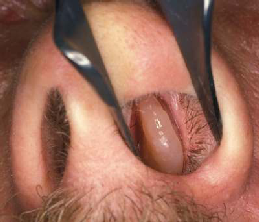Nasal Polyps
Part 1
Are These Growths Dangerous?
Unlike sinus cancer, nasal polyps (sometimes called "sinus polyps" or "sinus cysts") are not dangerous. These spongy, jelly-like polyps are benign growths found on the inner lining of the nasal cavity.

Sinus polyps are pink, yellowish or gray teardrop-shaped growths of swollen tissue that appear on the mucous membrane covering the surface of nasal passages and sinuses.
Small sinus polyps located in the nasal passage or sinuses usually cause no problems.
On the other hand, large growths and/or prolific clusters can restrict breathing through one or both nostrils and also slow down or prevent sinus drainage altogether by inactivating the cilia lining the mucus membrane.
Bacteria and viruses love this environment; without adequate drainage, puss filled pockets soon appear, followed by a vicious sinus attack -- and therein lies the hidden danger of nasal polyps.
<><><><><><><><><><><><><><><><><><><><><><><><><><>
There are Two Types
- Ethmoidal polyps, commonly found in the Ethmoidal sinuses situated above the bridge of the nose between the eyes. They can form multiple growths in both sides (known as “polyposis”), and are often visible when shining a light up the nostril.
- Antrochoanal polyps are less common and they are found in the maxillary sinuses behind the cheekbones. These polyps form single growths and are unilateral (appearing on one side only). In addition, since they are not readily accessible, antrochoanal polyps are harder to treat than Ethmoidal polyps.
Depending on their size and location, these growths may go from barely noticeable to extremely unpleasant.
Polyps range in size from tiny to about the size of a small seedless grape.
<><><><><><><><><><><><><><><><><><><><><><><><><><>
How the Mucous Membrane Works

As mentioned above, the nasal passages and sinuses are lined with a mucous membrane. This membrane contains millions of tiny blood vessels and minute hair-like growths called ‘cilia’.
Mother Nature demonstrated an incredible piece of biotechnology when she designed the mucous membrane. This mechanism performs three invaluable and breathtakingly elegant roles.
- The membrane continuously secretes a sticky fluid (mucus) in order to trap foreign particles, such as bacteria, viruses, dust, pollen and airborne pollution.
- The mucous membrane has a corrugated surface containing many nooks and crannies of varying depths. This not only increases its surface area, but also causes vortexes and eddies that agitate the inhaled air in a similar manner to river water flowing down a rapid. This action enhances the scrubbing and filtering effect of the sticky mucus. While this is happening, the cilia continuously sweep back and forth, thus propelling the saturated mucus outwards. The waste then exits through the nose and/or out the back of the throat.
- In addition to the static and turbulent filtering actions, the mucous membrane performs a third essential role. As the air flows over this extended area, it is heated or cooled (depending on the outside air temperature) to close to body temperature while being moisturized at the same time.
This automatic flushing action works like a dream -- that is until unwelcome polyps disrupt the air flow and force you to breathe through the mouth.
<><><><><><><><><><><><><><><><><><><><><><><><><><>
What Causes Nasal Polyps?
The precise biological action that initiates the growth of nasal polyps is largely unknown. However, there are clues; studies show that initial growth is triggered by a number of factors:
- Prolonged and sustained inflammation of the mucous membrane covering the sinuses and nasal cavities.
- People suffering from chronic sinusitis (long-term and repetitive) with attacks lasting longer that 12 weeks are prone to the development of sinus polyps.
- Age: People over the age of 40 often develop polyps for no apparent reason.
- Aspirin sensitivity, including sensitivity to other Non Steroidal Anti Inflammatory Drugs (NSAID's) such as ibuprofen, and naproxen.
- Allergens and pollution are a known cause of inflammation -- and inflamation encourages the growth of polyps; therefore people suffering from sinus allergies are at risk.
- This also applies to fungal growth in the nasal passages as experienced by people suffering from fungal sinus infection.
- Children with cystic fibrosis face a high risk of developing sinus polyps.
- Human Papilloma virus (HPV): A 2011 Chinese study published in the Journal of GEneral Virology states: "The data from our study clearly demonstrated that Human Papilloma virus infection was associated with sinus polyps.
- Young Syndrome
- Churg-Strauss Syndrome
- Nasal Mastocytosis
- Hereditary factors such as Primary Ciliary Dyskinesia, (also known as "Kartagener's syndrome")
There is ongoing research being conducted into the causes, treatment and prevention of these troublesome growths.
Next: Nasal Polyps Part 2
<><><><><><><><><><><><><><><><><><><><><><><><><><>
References
- PubMed: Aspirin Sensitivity
- SGM Journals: Human papillomavirus infection
- NIH – Young Syndrome
- Medicine.net - Churg-Strauss Syndrome
- PCD Foundation - Primary Ciliary Dyskinesia
- Cleveland Clinic - Nasal mastocytosis
Back to Home Remedy Site home page, from Nasal Polyps
<><><><><><><><><><><><><><><><><><><><><><><><><><>



